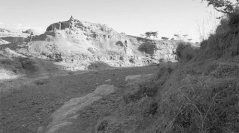

 Comptes Rendus Palevol
14 (8) - Pages 657-669
Comptes Rendus Palevol
14 (8) - Pages 657-669The archeological and paleontological area of Melka Kunture, in the Ethiopian highlands, has yielded particularly rich mammal fossil assemblages, including a few human and nonhuman primate remains. The cercopithecoid specimens reported so far consist of a fragmentary lower third molar crown and of a maxillary fragment, coming from the Early Pleistocene sites of Garba IV and Garba XII, respectively. In this study we describe an additional dentognathic specimen, labelled SIM III-13-1, collected in 2013 in the c. 1 Ma sedimentary deposits of Simbiro. In addition to classical descriptions and measurements, this specimen was detailed by X-ray tomography (CT) and two-three dimensional (2–3D) quantitative analyses were performed on the virtual reconstruction to assess its taxonomic assignment. Comparison with a number of fossil and extant cercopithecoid specimens/samples suggests that SIM III-13-1 belongs to the genus Theropithecus, more likely to Theropithecus sp. cf. oswaldi.
Melka Kunture, Simbiro, Ethiopia, Late Early Pleistocene, Theropithecus, Dentognathic remains